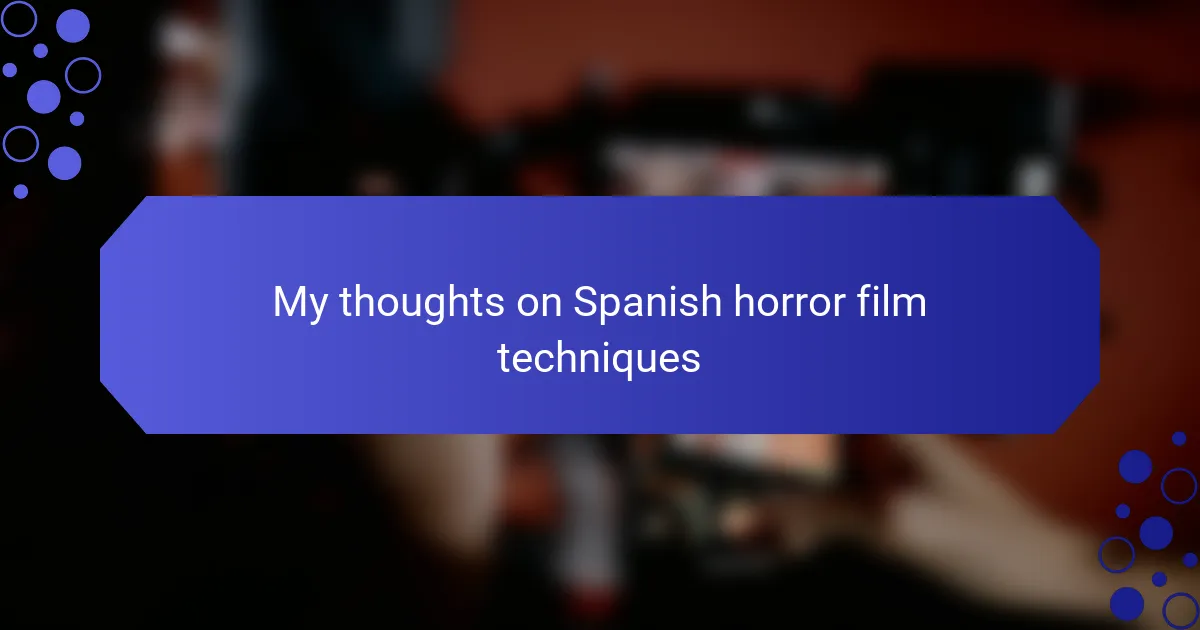Key takeaways
- Spanish horror cinema uniquely combines traditional folklore with psychological depth, focusing on mood and character-driven narratives rather than jump scares.
- Common techniques include deliberate pacing, atmospheric lighting, and a strong emphasis on sound design, creating an immersive experience that enhances tension.
- The storytelling often delves into psychological complexity and cultural fears, making the horror personal and relatable by blending the supernatural with familiar settings.
- To effectively use Spanish horror techniques, embrace subtlety, leverage sound and silence, and ground the narrative in cultural or emotional familiarity.
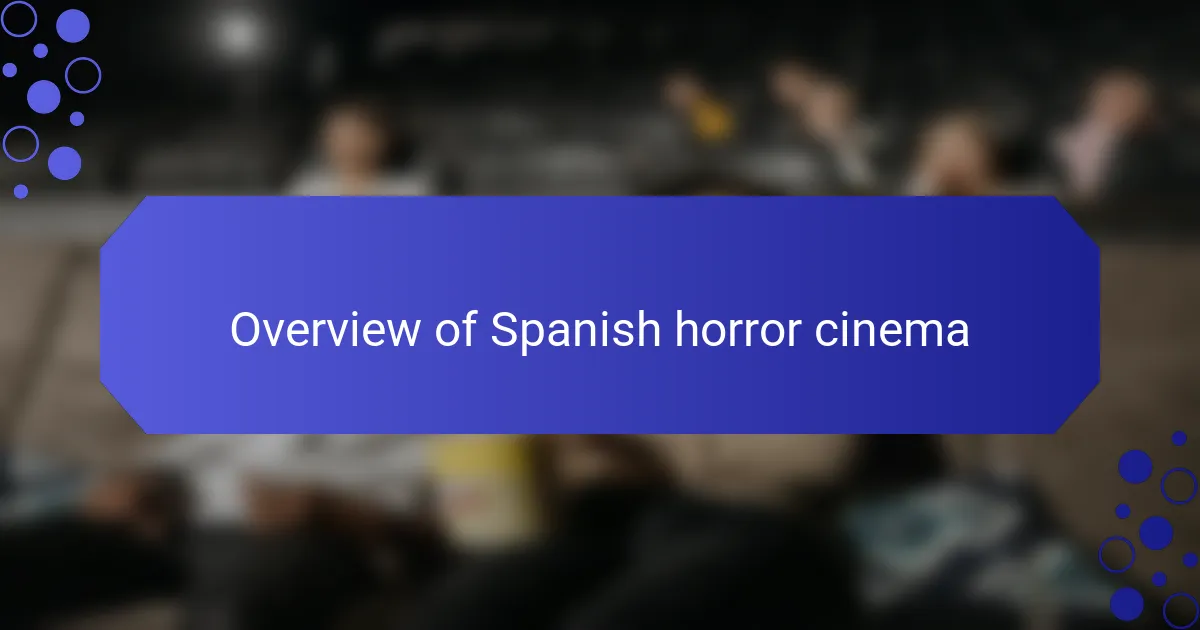
Overview of Spanish horror cinema
Spanish horror cinema has always struck me as a fascinating blend of tradition and innovation. Its ability to weave folklore and psychological depth into stories creates an atmosphere that feels both intimate and unsettling. Have you ever watched a film that stays with you long after the credits roll? For me, many Spanish horror movies do exactly that.
What sets Spanish horror apart, in my opinion, is its unique focus on mood and character-driven plots rather than relying solely on jump scares. The way directors build tension through shadowy visuals and haunting soundscapes draws me in every time. It’s like stepping into a world where fear is more about what lingers beneath the surface than what’s immediately visible.
I often find that Spanish horror taps into cultural fears and historical memories, giving the genre layers that you don’t always find in mainstream horror. This emotional resonance makes the experience feel deeply personal and, paradoxically, universal. Isn’t that the mark of truly effective storytelling?
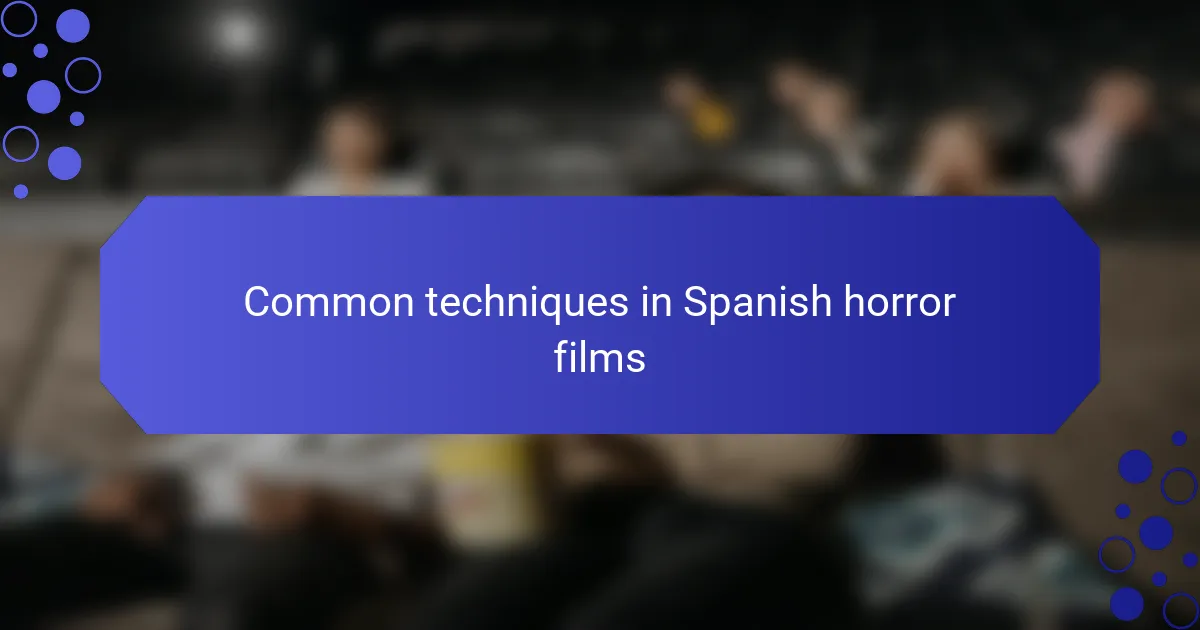
Common techniques in Spanish horror films
One technique I’ve noticed is the deliberate pacing that lets dread build slowly. Unlike many horror films that rush to shock, Spanish movies often take their time, making every creak and whisper feel significant. Have you ever felt your heartbeat synchronize with the suspense? That’s exactly the kind of immersive tension these films masterfully create.
Another thing that stands out is the use of lighting and color to reflect inner turmoil. Shadows often dominate the frame, blurring the lines between reality and nightmare. This approach reminds me of watching a story unfold through a fractured lens—disorienting but oddly mesmerizing.
Spanish horror also leans heavily on folklore and superstition, weaving these elements seamlessly into modern narratives. I find this fascinating because it roots fear in cultural identity, making the stories resonate on a deeper level. Don’t you think fear feels more real when it’s connected to the myths and histories we grew up with?
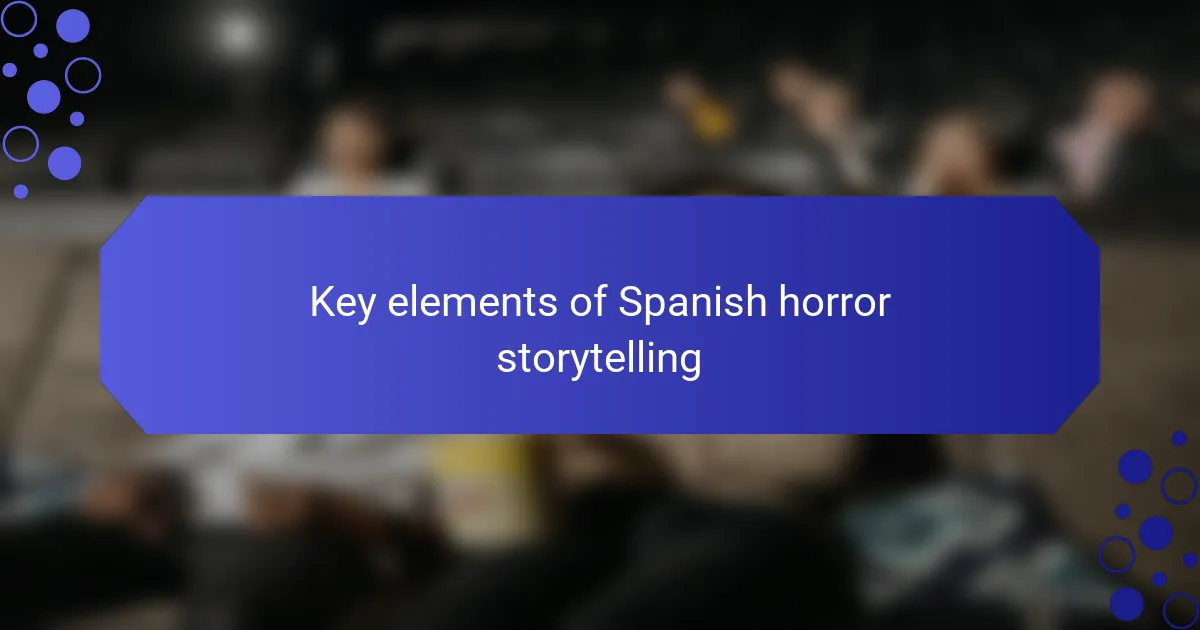
Key elements of Spanish horror storytelling
When I think about the key elements of Spanish horror storytelling, what immediately comes to mind is the emphasis on atmosphere over explicit gore. It’s not about shocking the audience with graphic visuals but rather about crafting a mood so thick with unease that you feel it creeping under your skin. Have you ever watched a film where the silence feels louder than any scream? That’s the kind of immersive fear these stories excel at creating.
Another element that intrigues me is the deep psychological complexity given to characters. These films don’t just show people reacting to horror; they explore how trauma, guilt, and suppressed memories shape their experiences. It’s like peeling back layers of the mind, and I find myself both fascinated and unsettled as the narrative digs deeper into their souls.
Finally, the blending of the supernatural with everyday life is something I appreciate deeply. Spanish horror often places ghosts, curses, or strange phenomena within familiar settings—a rustic village or a crumbling old house—making the unnatural feel disturbingly close to home. Doesn’t that proximity make the fear much more personal, as if what’s terrifying could be lurking just around your own corner?
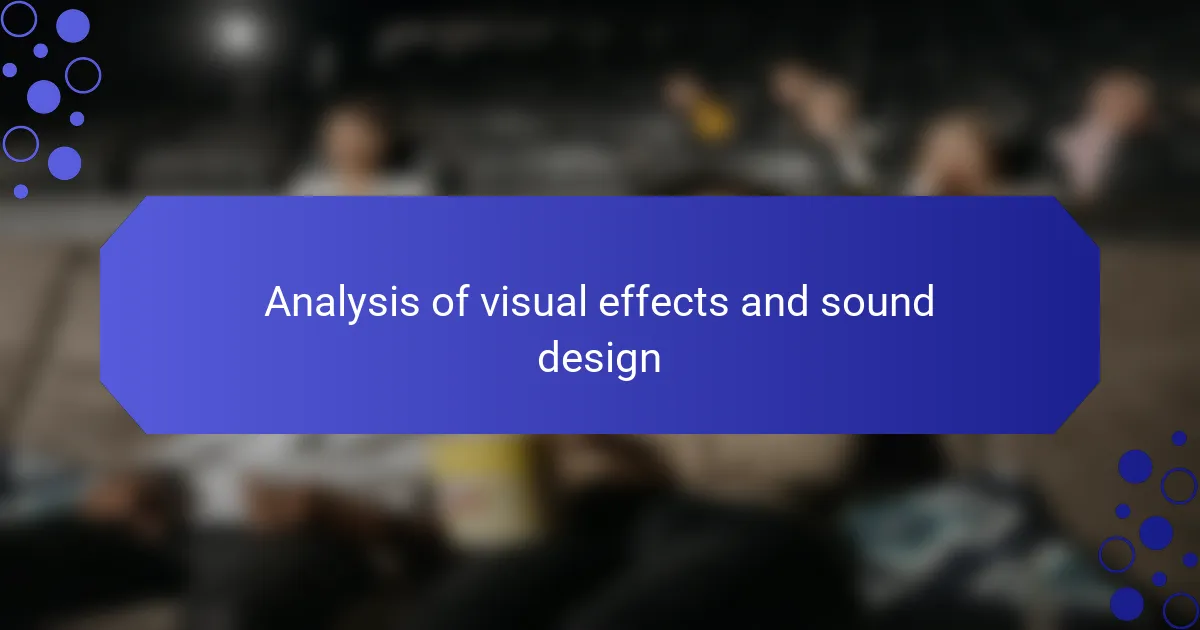
Analysis of visual effects and sound design
The visual effects in Spanish horror films often strike me as understated yet profoundly effective. Rather than relying on flashy CGI, these movies tend to use practical effects and clever camera work that make the eerie moments feel tangible and authentic. Have you ever noticed how a simple flicker of shadow or a subtle distortion can unsettle you far more than an obvious monster reveal? That restrained approach pulls me into the film’s unsettling world without breaking immersion.
Sound design is another area where these films truly shine, weaving an aural tapestry that enhances every spine-chilling scene. I’ve found that the use of ambient noises—like creaking floors, distant whispers, or sudden silences—creates a suspenseful atmosphere that grips me every time. Does it ever happen to you that the silence between sounds becomes almost unbearably tense? That’s a technique these filmmakers wield masterfully, turning sound and silence into emotional triggers.
What’s remarkable is how sound and visuals work hand in hand to blur the lines between reality and nightmare. For example, a distorted echo combined with a dimly lit room can make a simple hallway feel like an endless void. From my experience, this synergy amplifies the psychological horror more than any jump scare could. Isn’t that the true power of cinematic craft—making us question what’s real while keeping us glued to the screen?
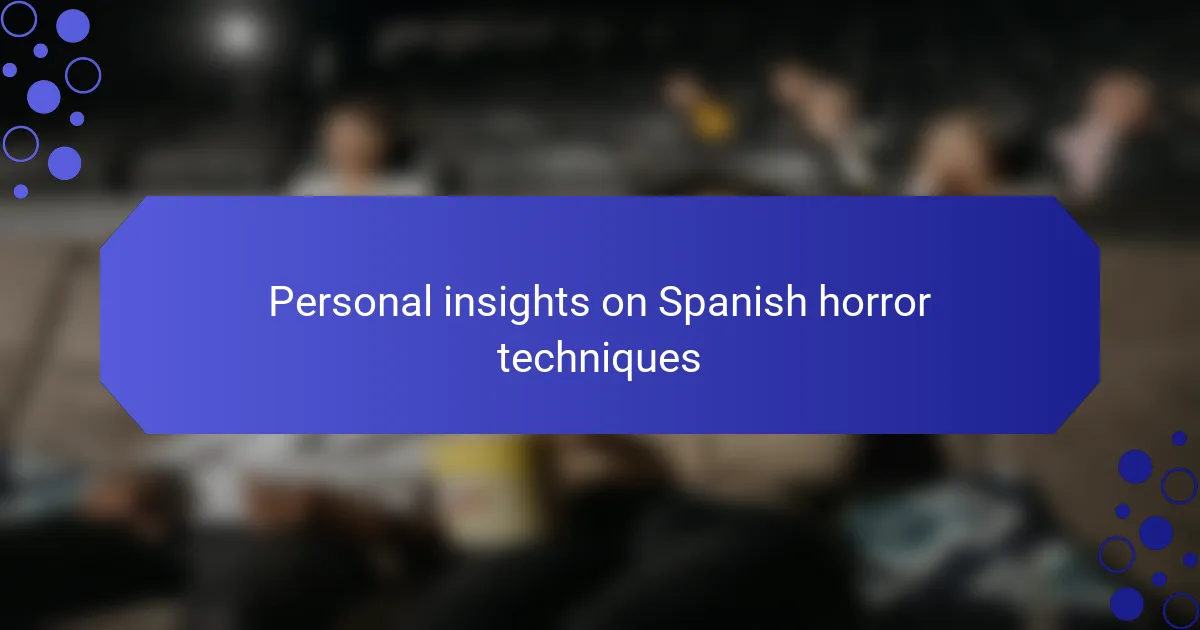
Personal insights on Spanish horror techniques
One thing that really stands out to me in Spanish horror is the way the camera lingers on seemingly ordinary moments, turning them into something charged with menace. It’s almost like the tension seeps through the frame, making mundane scenes feel deeply unsettling. Have you ever felt that quiet dread, where something feels off but you can’t quite put your finger on it? That’s the power of careful framing and patience in these films.
I’ve also noticed how the use of fragmented storytelling sometimes mirrors the characters’ unstable mental states, pulling me into their confusion and fear. This technique doesn’t just scare me; it makes me empathize, blurring the lines between viewer and subject. Isn’t it fascinating how narrative structure itself can become a tool to evoke horror, rather than just a way to tell a story?
Lastly, the subtle interplay between sound and silence creates a kind of psychological playground in my mind while watching Spanish horror. From experience, those moments when the soundtrack fades away entirely leave me holding my breath, waiting for the next unsettling noise. Do you find yourself hyper-aware of every small sound, even after the film ends? That lingering auditory tension is something I haven’t found quite the same way in other horror traditions.
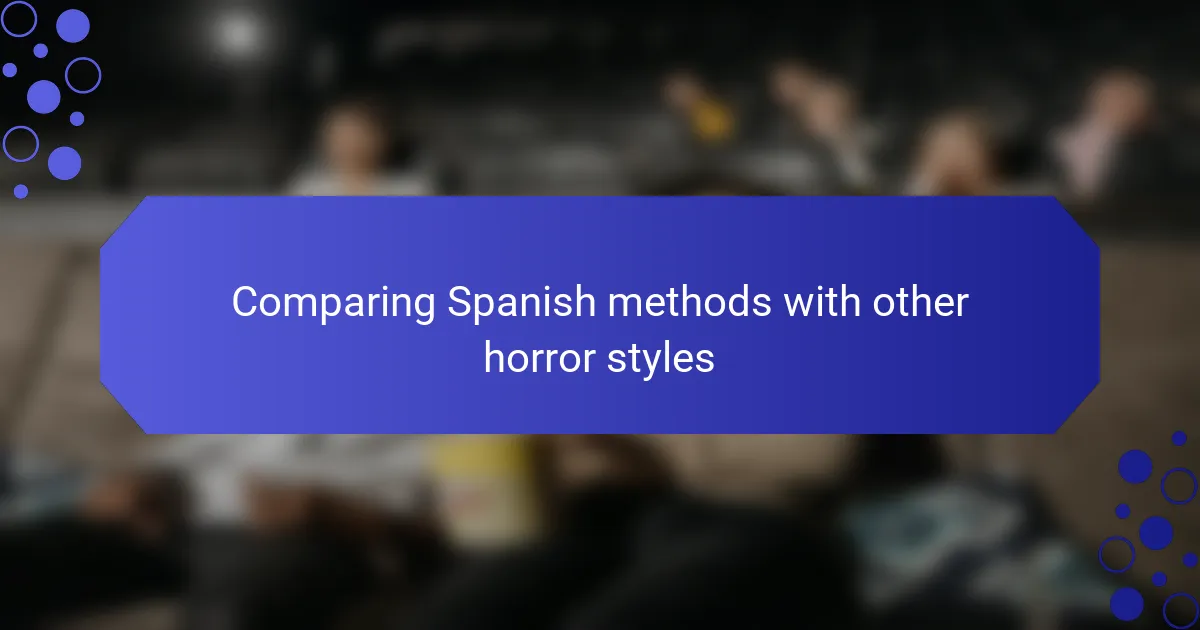
Comparing Spanish methods with other horror styles
When I compare Spanish horror techniques to those used in American or Asian horror films, what strikes me most is the pacing. While Hollywood often jumps to sudden scares or fast-paced action, Spanish films linger in silence and unease, letting the dread simmer slowly. Have you ever noticed how a prolonged moment of quiet in a Spanish horror film feels heavier, as if the tension itself is a presence in the room? That’s something I don’t see as often in other styles.
Another difference I find compelling is how Spanish horror roots its fear in cultural history and folklore, whereas other traditions sometimes rely more on universal monsters or abstract terror. This grounding in specific myths makes the stories feel more intimate and, ironically, more vivid. I’ve experienced that sense of personal connection many times watching Spanish films—doesn’t tapping into shared cultural memory make the fear feel more authentic?
Visually and sonically, Spanish horror’s restraint stands out to me when compared to the often flashy, effects-driven style of other genres. It’s like the filmmakers trust your imagination more, using shadows, subtle sounds, and suggestion rather than overt horror. Have you ever felt that a barely seen shadow or a muted whisper unsettled you far more than a grotesque creature on screen? That minimalistic approach feels deeply psychological to me and, frankly, a refreshing change from more conventional horror aesthetics.
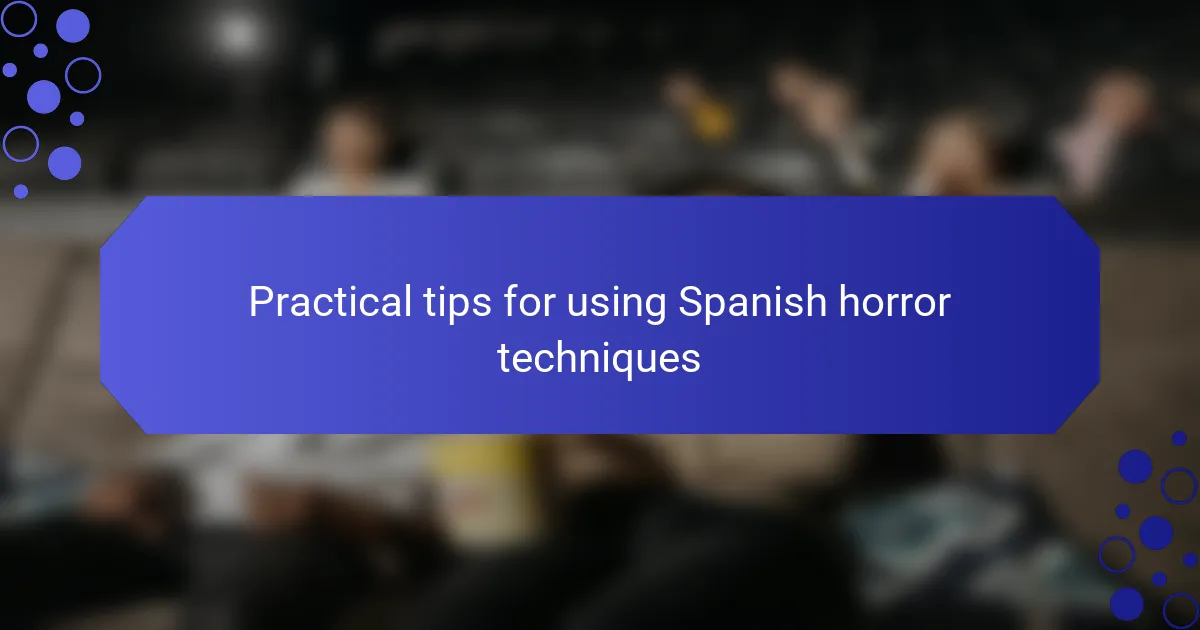
Practical tips for using Spanish horror techniques
When experimenting with Spanish horror techniques, I’ve found that embracing subtlety is key. Instead of rushing to show the monster or reveal the threat, let the tension build through quiet moments and lingering shots. Have you ever felt how a slow, almost silent scene can grip you tighter than a sudden scare? That patience really pays off in creating a lasting sense of unease.
Another tip I swear by is using sound and silence as active players in your storytelling. From my experience, layering ambient noises—like a distant creak or an eerie whisper—then suddenly dropping the soundtrack altogether can have a chilling impact. It’s amazing how these auditory shifts make you hold your breath, anticipating something unknown, isn’t it?
Finally, think about grounding your horror in something culturally or emotionally familiar. Drawing on folklore or everyday settings can make the supernatural elements feel much closer to home, which I find makes the fear hit harder. When I apply this, it’s like inviting the audience into a world where myth and reality blur, making the horror deeply personal and unsettling. Don’t you love it when a story haunts you because it feels like it could happen next door?
